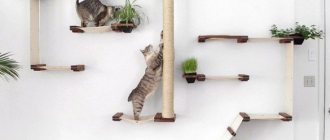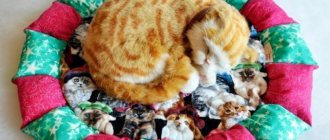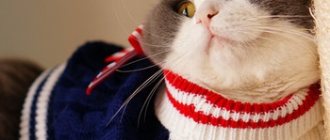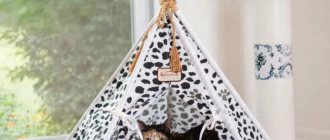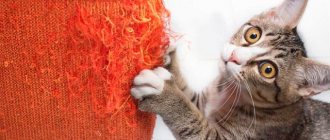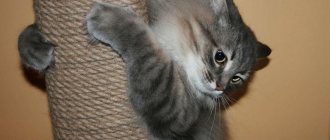Most often, preparations are made in advance for the arrival of a kitten in the house. Not only the breed is thought through, but also the details that can make his life as comfortable as possible - dishes, toys, litter box. However, are just these items enough? As cats grow older, an important need arises - the need to sharpen their claws. And so that your dream of having a cat does not turn into disappointment, you should still pay attention to the need to have a scratching post in the house. If you don’t want to buy one, then a scratching post for cats can be made with your own hands from available materials.
Types of scratching posts: floor, column, corner
What to consider when making
Before choosing a scheme and method for making a scratching post, you need to take into account, calculate, decide in advance on the size of the product, shape, what material to choose, place for placement and the further possibility of repairing the scratching post.
Size matters
The principle here is that the more, the better. The design should not be smaller than a cat. Even if you do a fight for a kitten, it should still be high, because the baby will soon grow up. A cat will simply not be interested in or comfortable with a small scratcher, because she likes to reach higher and further away.
If a floor structure is planned, the animal must fit completely on it (with front and hind legs). If it’s a vertical post or wall, make such a calculation so that the cat can accurately reach with its front paws and still have a little space left.
Base material
When choosing a material, it is better to give preference to natural wood or cardboard. These are soft enough materials that your pet won’t be able to injure their claws when sharpening. But it is permissible to use chipboard, fiberboard, and plastic sewer pipes, especially when it comes to the construction of an entire play complex.
Coating and winding material
For covering scratching posts, carpet and carpet fabric have the best qualities. It is recommended to purchase carpet for home use only. Office ones, as well as very cheap ones, are made on a rubber basis, can smell unpleasant, and be unsafe for the animal.
It is better not to use artificial fur or fabric, as they are short-lived, and fur tends to accumulate static electricity. The cat will be afraid of this design.
Jute (hemp) rope is made from industrial hemp, so it is safe for your pet even if swallowed.
Also, its advantages are that it is cheap, soft, and a good option for kittens. Disadvantages - when used, debris flies from jute, as it peels off into fibers. I'll have to clean more often.
Sisal rope is also made from a plant base (agave) and is not harmful to the animal. It is strong, but, like jute, it leaves behind debris. Another disadvantage of sisal is that during use by a cat, the scratching post can sag and become wet.
Cotton rope is also used to make scratching posts. It is reliable, safe, and due to the white color of the rope it gives the product more aesthetics.
Which of the presented options is better, each owner decides for himself.
Installation type and shape
Determined based on the size of the apartment and the availability of free space. Because you can make a nail sharpener in the form of a column or a floor-mounted horizontal one, or you can mount it on the corner of a wall.
Form – the simpler the better. The fewer corners and protrusions, the less the risk that the cat will damage its claws. This design is easier to repair when the coating fails.
Anti-vandal fabrics
Modern manufacturers meet the wishes of pet owners and produce special materials that can be used to protect upholstered furniture from the sharp claws of a pet. Scope of application of anti-vandal fabrics:
- as furniture upholstery materials;
- for removable covers;
- when making a sleeping place for a pet.
What to sew a cat bed from or make an unusual homemade ottoman? We list several of the most popular options for anti-claw fabrics:
- Flock. This two-layer fabric is combined from natural and polymer fibers and impregnated with a special compound that increases strength and resistance to wetness. The outer fibers have a long-lasting color and are resistant to stains. To remove dirt, simply wipe the flock with a damp cloth. For long-term use, the fabric can be washed in a washing machine. The fabric surface is smooth, so cat claws cannot catch and pull out the fibers. It is recommended to vacuum this material frequently, since flock is easily electrified (like any synthetics) and attracts dust.
- Relax is a combined synthetic fabric in which a base of cotton and polyester is covered with a layer of isoprene. Thanks to this composition, the fabric invariably retains a neat and elegant appearance and lasts for many years, requiring virtually no maintenance. Elastic material cannot be scratched. Dirt from the surface of the relaxation area can be easily removed with soapy water.
- Faux suede consists of two layers. The base is a mixed fabric made of cotton and polyamide, and the top fleecy layer is polyester. The advantage of this material is the absence of electrification and permeability to air. Wet cleaning and washing are not permitted. In case of severe contamination, you will have to invite specialists in chemical cleaning of furniture. Unfortunately, faux suede is not very durable, so a diligent cat can tear this fabric.
- Microfiber is a synthetic fabric formed by interweaving thin artificial threads. Typically, manufacturers impregnate the fabric with Teflon, which makes the material tear-resistant. This durable material is easy to care for: it can be machine washed and wet cleaned with a wet sponge.
- Tapestry fabric is a dense material formed by the interweaving of thick threads. The tapestry looks stylish and expensive. The only drawback is that the tapestry is afraid of ultraviolet radiation and easily loses its original shade in direct sunlight.
- Scotchgard is a jacquard weave fabric with water-repellent impregnation. This canvas is well protected from damage and always retains its original bright pattern. Allows dry cleaning, wiping with soapy water or a special cleaning agent.
The play complex was made by ourselves for kittens
Cattery kittens on a homemade three-story scratching post complex with beds, a house, and a hammock
Cardboard rectangular scratching post
With a rectangular or square option, the operating principle is the same:
- Cut cardboard strips of the same width and length depending on the desired size of the future scratching post.
- Make the base also from cardboard or use a ready-made box, then adjust the strips to its size.
- Glue each strip using a heat gun or other reliable glue, then lay tightly in a row next to the other until the box is completely filled.
- This design can be placed on the floor or fixed to the wall using double-sided tape. To do this, wide strips of tape are glued to the bottom of the box at the top and bottom, then the structure is attached to the desired location.
You can sprinkle catnip on the bottom (under the cardboard strips) or put a piece of fabric soaked in it.
Wooden scratching post
Essentially, a cat scratching post is a piece of carpet attached to a wooden or cardboard post. Therefore, making it at home is not difficult.
You will need:
- A piece of carpet or carpet to cover a wooden post and base.
- Wooden pillar.
- Drill.
- Glue or staple gun.
- Hammer.
- Screws – 2 pcs. 7-8 cm in length.
- Paper knife or scissors.
Wooden products can be purchased at a hardware store.
It is better to choose a pole longer than the cat; the width of each side, if it is square, is at least 10 cm. The base (round, square, rectangular platform) must be heavy enough so that the animal does not tip over the structure. It is better to use a carpet without loop pile - it will quickly fail. Step by step manufacturing steps:
- The structure will be held in place by 2 screws that will go through the platform and into the post. Mark marks for the holes in the wooden beam with a pencil. Then place marks on the base at the same distance. It turns out that if the holes for the screws on the block are at a distance of 5 cm, then they should be at the same distance on the base.
- Drill 2 holes in the base for screws.
- Glue or staple the carpet to the post. Gluing is more difficult, as the carpet will jump off and not lie flat. When working with a stapler, you need to take into account when the post will stand vertically so that the staples are also positioned vertically. This way there is less risk that the cat will damage the claw.
- Then wrap the other side with carpet and also secure with a stapler. The post needs to be wrapped as tightly as possible. Trim off the excess with a knife and secure with staples. Be sure to hit the staples with a hammer to make them flatter. The scratching post area can be covered with carpet, but if it is well sanded and free of splinters, it can be left as is.
- Screw the screws into the base, place the post on them and continue screwing until the head rests on the wood.
How to discourage a cat from sharpening its claws in a “forbidden” place
| First of all, a certain smell will help. Animals have a more highly developed sense of smell and some aromas are categorically unpleasant to them. The smell of alcohol, for example, or perfume.
Cats don't like the smell of all citrus fruits. You can purchase a special spray based on aromatic oils at the pet store. All rights reserved.
| Usually animals quickly abandon places where they are supposed to be in danger. A loud bang, a stern hail, and wrapping furniture in cellophane are also effective.
Many people recommend “water procedures” from a spray bottle, but this is possible if a cat is somewhere nearby trying to sharpen its claws, and the owner is sitting fully armed, waiting for her. Everyone can invent the ability to dare an animal themselves, knowing all its pros and cons.
.
Carpet scratch board
You can quickly and easily make your own carpet scratching post. To do this you will need:
- Wooden board or piece of chipboard.
- A piece of carpet or old carpet.
- Nails.
- Hammer.
The size of the wooden canvas is selected based on the size of the cat, because the structure made can be used as a bed and as a claw sharpener.
How to make a nail clipper:
- Place the rug with the wrong side up.
- Stepping back from the edge of the carpet, place the board.
- Wrap part of the carpet over the board and secure with nails along the entire edge.
- Carry out the same actions with the second part of the carpet. If the two layers overlap, they can be cut off with a knife or left as this will create an extra springy feel for the cat.
For the cat to start using the scratching post, just turn it over to the other side. If a fairly heavy tree is chosen for the scratcher, then it may not be secured, and the cat will still not turn it over.
Make or buy?
A good, “correct” scratching post costs about 600 rubles. It will have to be changed 2-3 times a year. It seems like God knows what kind of expense it is, but mass-produced products are designed for average representatives of certain breeds, and cats, as you know, are animals with character. Therefore, the optimal solution, since there is a fluffy in the house, is to make him a scratching post with your own hands, after first observing the pet and choosing the right one for him . Which one and how – this is the material of this article.
Scratching post with sisal
Another simple way to make a scratching post from wood, a piece of rope and carpet.
To make a cat scratching post, you will need:
- Square base made of wood or chipboard.
- Wooden pillar.
- A piece of old carpet or rug.
- Sisal rope.
- Carpet adhesive or stapler, staples.
- Screwdriver, drill, saw.
Sequencing:
- Prepare the base. To do this you will need a saw to get the required dimensions. Sand the edges so that no sharp parts stick out.
- Do the same with the post - if necessary, shorten it with a saw and sand it.
- In the center of the base, determine 2 or 4 points where the screws will be inserted. It's simple: draw 2 lines from one corner to the opposite. At the place where they intersect, install a pillar and trace its diameter with a simple pencil. Mark 2 (4) points for drilling in the center of the circle.
- Drill holes in the base for further insertion of screws.
- Then the holes need to be drilled in the post. In order not to accurately measure with a ruler, you can do it simpler: turn the post over, firmly place the base on it (you will need the help of a second person for this) and drill along the existing holes.
- Glue the carpet to the base. After the glue has dried, turn the base over and use a cardboard cutter to trim off any excess carpet.
- The next step is to wrap the post with sisal. You need to start from the bottom, gradually rising to the top. The beginning of the rope will need to be secured with glue. Then wrap the rope tightly around the post and periodically fix it with glue for a tighter fit. Apply glue at the very top and also lay the rope in a circle. Cut off the tip, glue tightly in src=”https://68koshek.ru/wp-content/uploads/2021/02/namatyvanie-verevki-na-stolb.jpg” class=”aligncenter” width=”580″ height=” 413″[/img]
- Connect the base and the post by screwing in the screws with a screwdriver.
- For better stability, so that the screws do not protrude onto the side that is in contact with the floor, glue a rubberized backing and cut a piece in the area of the screws so that they do not come into contact with the floor.
You can also attach pompoms to this setup with a strong thread. The kitty will be able not only to sharpen her claws, but also to play. As the rope wears out, it is easy to carry out repairs and re-install a new one.
If there is not enough space in the apartment, the easiest option is to wrap a rope, jute cord, sisal around a table leg or part of some other furniture.
Option 6: two-story claw house
A scratching post with a cat house is ideal for the whole family of cats, especially if kittens have recently appeared. All their attention will be concentrated in the play area, where they can also relax. Step-by-step instructions are provided below.
Materials
To increase interest, you can additionally introduce a small branch. Walking through the forest, you can always find dry driftwood, which, after varnishing, will become an ideal addition to the interior. What else:
- plywood - 2 sheets;
- sisal - the amount depends on the size of the entire structure;
- textile;
- saw;
- screwdriver
All this is usually in the garage or utility room, so a luxurious cat house will turn out to be very budget-friendly, but beautiful.
Drawing
You can find a detailed diagram of a scratching post for cats on the Internet. Owners often post finished masterpieces on social networks. Based on them, you can create your own project on a simple A4 sheet. If there are several cats, it is advisable to make the house larger. Be sure to allocate a place in the apartment where pets feel protected.
Note!
Do-it-yourself illuminated mirror - step-by-step master class on how to make it yourself, photos of types of lighting
DIY flower stand - TOP 100 photos of stand options, detailed instructions, diagrams and drawings from the masters
Do-it-yourself furniture restoration: restoration methods, step-by-step master class, necessary tools and materials
Important! The branches can serve as scratching posts and beams on which houses will be supported. In this case, they are not varnished, but wrapped with twine.
Wall-mounted scratching post for upholstered furniture
This model is especially for a cat who does not want to change his favorite sofa for anything else.
You will need 3 wooden boards. One is for wrapping with sisal rope, the second is slightly wider in size than the sofa armrest, the third will hang from the inside of the sofa as a retainer. In general terms, the design resembles the letter G and is hung on the side back of the sofa.
Should I have an onychectomy?
Finally, we should remind you of the operation permitted in some countries to remove the claws of the Domanikomanina Yes, this procedure will save the owners from a lot of trouble and will preserve the furniture, but is it really that harmless? After all, along with the claws, the front phalanges of the fingers are removed, which affects the work of the entire support system.
A cat is a fairly mobile animal and without claws it is doomed to endless injuries - clinging is impossible. She will not be able to climb onto a low surface; it will be difficult for her to maintain balance. After the operation, you may suffer from pain for the rest of your life, which is due to a violation of the habitual state of the body.
Corner scratching post
The simplest option for a corner claw is to cover the corner of a doorway or wall with a piece of carpet.
Another option is to build 2 flat poles of the same size and attach them to the corner on both sides.
Would need:
- Jute rope
- 2 boards identical in width, thickness, length. Wooden boards, chipboards, and wall panels are suitable.
- Drill.
- Screws.
- Glue.
Mark holes for screws in each board. Then wrap it tightly with a rope secured with glue and screw the boards at the desired height into the chosen location.
A more thorough approach to making a corner fight in a video story
Travel scratching post
If you often have to travel somewhere with your cat, it is advisable to take her favorite accessory for entertainment and exercise on the road. In addition, such a mobile hanging scratching post can also be used at home on an ongoing basis.
You will need:
- A rectangular board or sheet of plywood.
- Rope (rope, jute, sisal).
- Glue.
- Drill.
- Scissors.
Make 2 holes in the board, into which then thread a rope for hanging.
Wrap the board tightly with rope, gluing it periodically. Also fix the ends with glue.
How to draw a cat's attention to a scratching post
Placing a scratching post in a certain place is not enough for the cat to pay attention to it. Your cat may need to be trained to use a scratching machine.
Some tips:
- Observe where the cat most often settled down to sharpen its claws and, if possible, install a scratching post nearby.
- Show him the “right” behavior. To do this, bring the cat to the scratching post, place its front paws on it, lightly pressing on the center so that the cat releases its claws.
- Be sure to praise your pet. Give a treat, but never scold.
To attract a kitten or adult cat to the scratching machine, you can use catnip. The product is sold in pharmacies and pet stores in the form of dry herbs, sprays, and infusions. Some furry owners use valerian, but it is better not to use this method. Since valerian can have completely unexpected effects on cats.
Preparation of materials
It is a common belief that when cats damage furniture, they become in need of sharpening their claws, although in fact the main task lies elsewhere. In this way, pets remove the stratum corneum from their claws, making them suitable for hunting. Therefore, it is important that the materials meet the needs of the pet and are as close to natural as possible.
The scratching post can be made of wood (birch and any conifers except spruce are best) or thick corrugated cardboard. The second option is good for small breeds and kittens. I do not recommend making the base out of plastic and metal, because both materials are unpleasant and dangerous for cats.
You can upholster the structure with dense, coarse materials, for example, a piece of fabric from an old woolen coat. Drape and tapestry work well. But the simplest option is rope, which is sold in fishing stores, or thick jute for the furniture industry.
In addition, you will need PVA glue or a glue gun. An alternative is a furniture stapler.

